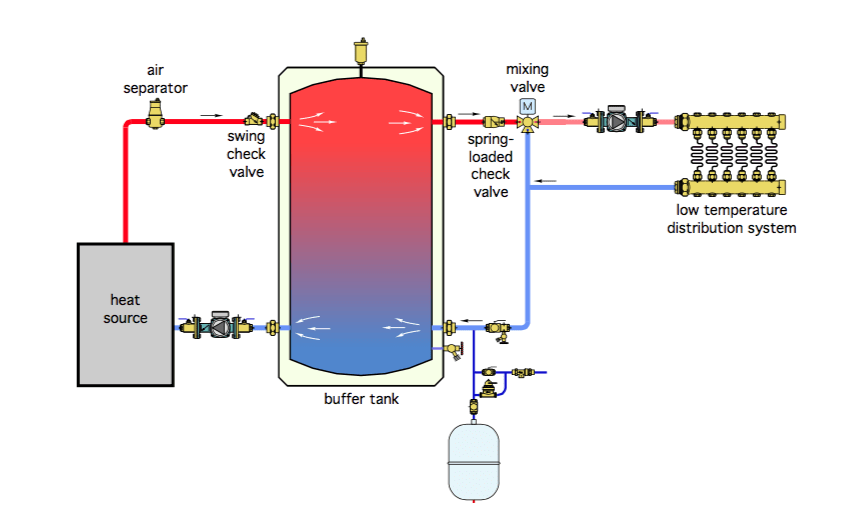One of the most asked question is do I need a buffer tank with a hydronic heat pump? Despite trying to save some dollars by not purchasing a buffer tank, it is always recommended and should be included in any hydronic heat pump system including both geo thermal and low temperature heat pumps such as Arctic Heat Pump. There are a few reasons why a buffer tank is used.
- Different flow rates – a hydronic heat pump or geothermal have high flow rate requirements typically about 3 gallons per ton. This means a 4-ton heat pump will need 12 gallons per minute flow. However, hydronic heating requires a much lower flow rate of typically .75 GPM per loop. In order to accommodate two different flow rates, you require a buffer tank or some other type of hydronic separator.
- Reduce Short Cycling of the System - Depending on the size of the hydronic loop, the heat pump will quickly heat the volume of liquid quickly and then shut down. This mean frequent on/off starts on the compressor and heat pump. Especially with single and two stage compressors, the frequent starting and stopping can cause early failure on the units. The DC variable speed inverters are less prone to this problem, but it still can add more stress on the system.
- Add Energy Battery to the System – The buffer tank store BTU of energy. Depending on the size of the buffer tank you can store more energy. 1 BTU is the amount of energy required to heat up 1 LB of water. An 80-gallon storage tank can store 668 lbs. of water (1 gallon = 8.36 Lbs.) So if we heat a tank to 160 F and use the stored energy up to 90 F. We have 70 degrees of energy we can use (160-90). There for in an 80-gallon storage tank we can store 46,760 BTU based on our example (668 lbs. x 70F). If we raise the water temperature we can store more and if we increase the size we can store more. So this storage battery can store 46,760 BTU or 13.7 Kw hrs. This is important especially with an air source heat pump as the demand and production is offset. What this means is normally the day time is warmer, so the tank can be loaded during optimal hours and during the night there is more of a demand that can be supplied in part by the stored energy in the buffer tank. By storing the energy, we can make more efficiency with the cold air heat pump.
- Two mediums – Normally the fluid in a cold weather heat pump uses some antifreeze which is typically polypropylene glycol. In order to separate this from potable water for domestic heating we need to use a heat exchanger. To get the maximum exchange it is best for a large coil heat exchanger. The Eco ULTRA has the option of a 160 foot internal heat exchanger inside the buffer tank. Without the larger storage capacity there would be much less of a heat transfer available so the buffer tank aids in the transfer of the energy from one medium to another.
- Back up- A Cold weather heat pump has a paradox that the colder the temperature is the less energy it is able to produce. Proper sizing is important but ultimately a backup heating source may be required. Sizing a heat pump to the absolute coldest day is not recommended. Instead it should be sized to the average temperature of the coldest month. This means that there will be short periods where the temperature drops below the average and a backup heating source is needed. The best and most cost-effective means to supply extra heat is a heat element found in some buffer tanks. Until now most contractors and installer used a standard potable water tank that by code was limited to a 4.5 Kw heating element. Unfortunately, this is not sufficient heat back up for most houses. So by using our EcoULTRA tanks you can size the back up to suit the total house demand of up to 29 Kw. This means should there be a complete failure you would still have full heating solution. Our EcoULTRA buffer tanks also have the ability to communicate directly with the Arctic Cold Weather Heat Pump and supply on the amount needed. So even though a system can supply much more it will only supply the exact amount required to satisfy the total system.
So, in summary a buffer tank is a key part to any hydronic heat pump system. DIY installers can choose to use off the shelf hot water tanks to save money. If a customer has an existing hydronic system, the buffer tank can utilize a dual heat source for the backup but it is still recommended to always include a backup. We recommend minimum 15 gallons per ton of buffer, but more is better!


